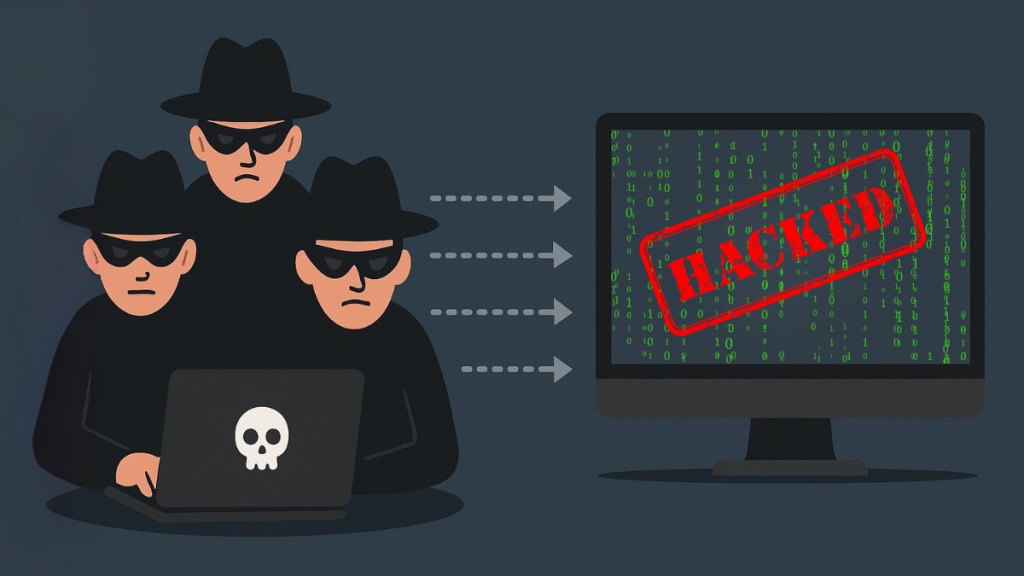Let’s break down how to secure your WordPress blog—whether you’re a beginner or a seasoned pro new to self-hosted websites.

Why Should You Secure Your WordPress Blog or Website
Why Secure What You Built?
You’ve spent valuable time—and likely some money—getting your WordPress blog or website off the ground. Whether it’s the foundation of a side hustle or a new digital career, your site represents your ideas, brand, and potential income. Leaving it unsecured is like parking your car with the doors unlocked and the keys on the dash. Hackers don’t need permission—just an opening.
Who Are These Hackers and Why Would They Target You?
Unethical hackers—also known as bad actors—use automated bots to scan the internet or entire blocks of IP addresses looking for known vulnerabilities in WordPress and its plugins. Once a vulnerability is found, your site can be used to deface content, steal traffic, inject malicious code, send spam, or worse. And don’t think being “small” makes you safe—even a personal blog can be exploited as a tool in larger attacks. If that happens, you could end up dealing with downtime, legal consequences, or a damaged reputation.
Top Ways to Protect Your WordPress Blog From Hackers
In this guide, we walk through how to secure your WordPress blog using a two-pronged approach: beginner-friendly site protections and deeper server-side hardening.
Basic protections include:
- Using strong passwords and creative usernames
- Choosing reputable plugins from trusted sources
- Managing user roles and limiting access
- Backing up your blog regularly
- Enabling automatic updates and SSL
Server-level hardening includes:
- Disabling directory listings
- Restricting access to sensitive areas by IP
- Blocking PHP execution in vulnerable folders
- Protecting config files
- Adding security headers and tightening permissions
If you’re still reading, chances are you’re serious about protecting your WordPress site—and that puts you ahead of most blog owners.
Beginner WordPress Security: Day One Steps
Strong Passwords Matter
Always use a strong, unique password for your WordPress blog. That means mixing uppercase and lowercase letters, numbers, and symbols. Avoid using names, birthdays, or anything personally identifiable. Never reuse passwords across accounts.
If you struggle to create or remember strong passwords, consider using a password manager like Bitwarden or even Firefox’s built-in password generator. Writing them down (and storing securely) is still better than reusing weak ones.
Avoid Common Usernames
When creating admin, editor, or contributor accounts, don’t use usernames like admin, root, or user. These are the first names hackers attempt when brute-forcing logins. Also avoid obvious choices like your blog name or author name. Be creative—think of your username as part of your security strategy.
Keep WordPress Updated — Always
Outdated plugins and themes are one of the top ways hackers break into WordPress sites. Don’t leave the door open—enable auto-updates for your plugins, themes, and even WordPress core.
You don’t need to manually check every day. Just toggle “Enable Auto-Updates” in your plugins page, and let WordPress handle it.
Use an SSL Certificate
SSL (Secure Sockets Layer) encrypts the data between your site and its visitors. It’s the standard now and essential for trust and SEO. An SSL-secured blog displays a padlock icon in the address bar and switches your URL from http:// to https://.
Most hosting providers offer free SSL certificates via Let’s Encrypt, and you can enforce SSL via plugins or .htaccess.
Always Backup Your Blog
Even with the best protection, things can go wrong. Whether it’s a hack, server crash, or a bad update—backups save you.
You can back up manually via your hosting control panel or use a plugin like UpdraftPlus or Jetpack Backup to automate it. Store backups offsite (like Google Drive or Dropbox) for extra safety.
Be Smart About WordPress Plugin Security
Plugins are powerful—but they can also be risky if misused. Only download plugins from trusted sources like WordPress.org. Avoid shady websites and “nulled” premium plugins, which often contain malware.
Before installing a plugin, check:
- Last updated date (within 6 months is ideal)
- Number of active installs
- User reviews and support activity
- (Optional) Source code or GitHub repo, if you’re technical
Active and well-reviewed plugins are your safest bet.
Starter Security Plugin Stack (Free Tier)
Here’s a well-rounded, free security plugin stack that covers the essentials without overlap:
Wordfence Security
Covers: Firewall (WAF), malware scanning, brute-force protection
Why it’s essential: Acts as your site’s first line of defense. Free version includes a powerful local firewall and malware scans.
WPScan
Covers: Plugin, theme, and core vulnerability detection
Why it’s essential: Scans your WordPress installation for known vulnerabilities using the WPScan vulnerability database.
WPS Hide Login
Covers: Hides your login URL
Why it’s essential: Stops most bots from even reaching your login page. Simple yet effective.
WP 2FA (Two-Factor Authentication)
Covers: Adds 2FA to user logins
Why it’s essential: Prevents unauthorized logins even if your password is stolen.
UpdraftPlus
Covers: Automatic backups of files and database
Why it’s essential: Quickly restore your site in case of an attack or error. Free tier supports offsite backups.
Disable XML-RPC
Covers: Blocks a commonly exploited endpoint
Why it’s essential: Reduces your blog’s exposure to brute-force and DDoS attacks. Safe to disable unless you use Jetpack or remote publishing.
Server Side Security
Disable Directory Listing
Prevents visitors (and bots) from browsing your folder structure if an index file is missing. If using Apache, add the following to .htaccess.
Options -Indexes
Limit Access to /wp-login.php and /wp-admin by IP
Restricts login and admin access to specific IPs (your home or office). If using Apache, add the following to .htaccess.
<Files wp-login.php>Order deny,allowDeny from allAllow from <your.ip.goes.here>
Disable PHP Execution in /wp-content/uploads/ and other folders
Stops attackers from uploading and running malicious PHP scripts. If using Apache, add the following to .htaccess.
<Files *.php>deny from all</Files>
Protect wp-config.php and .htaccess Itself
Prevent public access to critical files.
<files wp-config.php>order allow,denydeny from all</files><files .htaccess>order allow,denydeny from all</files>
Do I Really Need to Secure My WordPress Site? Final Thoughts
Securing your WordPress blog isn’t just a technical task—it’s a vital part of protecting your time, your ideas, and potentially your income. Whether you’ve built your site as a passion project, a side hustle, or the start of a new career, keeping it secure means safeguarding the effort and ambition behind it. Hackers and bots don’t discriminate based on site size—they look for weaknesses, and even a small vulnerability can lead to downtime, data loss, or reputation damage.
By following the steps in this guide—from using strong passwords and trusted plugins to implementing smart server-level protections—you’re building a secure foundation that keeps your site running smoothly and your audience safe. WordPress security is ongoing, but it doesn’t have to be overwhelming. With the right tools and a proactive mindset, your blog can grow with confidence.
If you’re just getting started and haven’t launched your site yet, check out this guide to building your WordPress blog on DigitalOcean — it walks you through every step of setup so you can start off strong and secure from day one.

Leave a Reply